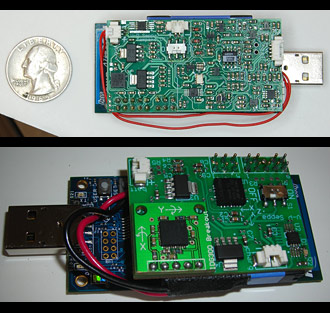Sensors Could Give Elderly an Assist
 Wearable motion sensors such as these can pick up biological and positional data, enabling seniors to live more safely on their own. The project is under development by Berkeley’s TRUST, the Team for Research in Ubiquitous Secure Technology. Most people hope to live healthy, independent lives through their elderly years. But that’s not always the case because, as people age, they and their loved ones have to worry about not only illnesses, but also injuries, especially from falls. For seniors, falling is the leading cause of injury deaths, nonfatal injuries and hospital admissions for trauma, according to the Centers for Disease Control and Prevention. In 2005, more than 433,000 people over the age of 65 were hospitalized because of falls, and 16,000 people died from fall-related injuries. As baby boomers grow older, those numbers will only increase.
Wearable motion sensors such as these can pick up biological and positional data, enabling seniors to live more safely on their own. The project is under development by Berkeley’s TRUST, the Team for Research in Ubiquitous Secure Technology. Most people hope to live healthy, independent lives through their elderly years. But that’s not always the case because, as people age, they and their loved ones have to worry about not only illnesses, but also injuries, especially from falls. For seniors, falling is the leading cause of injury deaths, nonfatal injuries and hospital admissions for trauma, according to the Centers for Disease Control and Prevention. In 2005, more than 433,000 people over the age of 65 were hospitalized because of falls, and 16,000 people died from fall-related injuries. As baby boomers grow older, those numbers will only increase.
But one team of researchers is working to enable the elderly to live independently through a network of body sensors. The project, in development for the past four years, could allow computers to remotely monitor and analyze the activity of seniors so that, if they fall or stop moving, help can arrive quickly.
The body sensor network project is funded by the TRUST program, the Team for Research in Ubiquitous Secure Technology, headed by UC Berkeley and created in 2005 with a $19 million grant from the National Science Foundation. Engineering dean S. Shankar Sastry is the principal investigator and director.
The interdisciplinary and multi-university sensor project group, headed by Berkeley EECS professor Ruzena Bajcsy, has built a prototype consisting of wireless sensors that are strapped onto the user’s wrists, ankles and waist. The sensors, which can be biological and positional, can pick up data like the user’s location, speed, direction, angles of motion, breathing capacity and heart activity. The sensors feed the information back to a Nokia tablet, which can use cell or Wi-Fi networks to send data to remote computers, located anywhere, for real-time processing. The team uses commercially available hardware and has designed open-source software for the application.
The sensors can be used for both research and practical purposes. For example, they could collect data from seniors to help researchers understand which situations pose high risks for falls or fractures. Ideally, such studies would lead to public policy changes to improve the lives of elderly, says Edmund Seto, a researcher from Berkeley’s School of Public Health, who is part of the team.
In other scenarios, the sensors could gather information through accelerometers and gyroscopes to recreate the user’s motions virtually and help in disease treatment. Allen Yang, an EECS research engineer at Berkeley, explains, “For example, if you bring a child with muscular dystrophy into the doctor’s office for 30 minutes, he is asked to do signature activities, which leads to a diagnosis. But, if the sensors are on kids 24/7, the doctor could monitor remotely and would have a whole week’s worth of information.”
Data for individuals can be fed into electronic medical record systems or used in health studies. One possible research area is respiratory health. “If you know the location and respiratory rate of an individual and can link this data to measurements from air pollution monitors, you can learn something about exposures to air pollution that lead to asthma attacks,” Seto says. Another potential area for study is obesity. “Why is it that some children don’t get as much exercise as others?” Seto asks. “Does it have something to do with their communities and where they live? If we could understand children’s activity patterns by using these sensors, we might be able to understand the problem and design better communities.”
Apogee Electronics has licensed the technology and plans to bring the product to market. Researchers say they don’t know how much the product would cost and don’t have a specific timeline for commercialization. For now, they are focusing on testing the sensors to make sure that security is built into the software from the beginning. They want to ensure that the programs collect accurate data and that those data are secure, so that sensitive information doesn’t get into the wrong hands.
Other researchers on the project include Berkeley’s Annarita Giani, Sameer Iyengar, Roozbeh Jafari, Victor Shia, Curtis Wang and Posu Yan, and Philip Kuryloski from Cornell. Ville-Pekka Seppa from the University of Tampere in Finland developed the biosensors, and collaborators from Telecom Italia are behind the software framework that powers the sensors.
Go to www.eecs.berkeley.edu/~yang/software/WAR/ for more detail on the project.
